|
Dongjiang (DJ) water is the main source of fresh water for Hong Kong, accounting for about 70 to 80 per cent of our total fresh water supply. To gain first-hand information on the DJ water supply facilities and the Mainland’s work on water quality monitoring, I, together with colleagues of the Water Supplies Department (WSD), joined 18 Legislative Council (LegCo) Members, in their duty visit to the DJ River Basin organised by the Panel on Development of LegCo last month. On 22 May, the Development Bureau (DEVB) and the WSD arranged a follow-up visit for LegCo Members to the Muk Wu Pumping Station adjacent to Shenzhen River and the Tai Po Water Treatment Works, so that the legislators have a better understanding of the WSD’s work on water quality monitoring and water treatment. The visit can be seen as a continuation of the duty visit to the DJ River Basin which aims to enable the public to better grasp our sustained effort to ensure water safety.
Currently, DJ water is transported from the Taiyuan Pumping Station in Dongguan on the Mainland (i.e. the intake point of DJ water supplied to Hong Kong) to the Shenzhen Reservoir through dedicated aqueducts, and then to Hong Kong. The Muk Wu Pumping Station that LegCo Members visited on this occasion is the first stop for Hong Kong to receive DJ water; it is also the starting point of distributing DJ water to various water treatment works and impounding reservoirs. At present, the Muk Wu Pumping Station comprises two pump houses, namely No. 2 Pumping Station and No. 3 Pumping Station, which commenced operation in 1984 and 1994 respectively. There are a total of 22 giant water pumps in the stations designed for a daily water supply of 3.9 million cubic metres (equivalent to the capacity of about 1 500 standard swimming pools).
Collect samples to ensure water quality
On the day of the visit, WSD colleagues briefed LegCo Members on the three-tier water quality monitoring system adopted by the Muk Wu Pumping Station and how the Hong Kong side closely monitors DJ water quality. The first tier is the on-line water quality monitoring system, under which the WSD carries out round-the-clock and real-time monitoring of changes in the quality of DJ water, including its dissolved oxygen, chlorophyll, pH, turbidity, conductivity, temperature and ammoniacal nitrogen level. The second tier is the on-site primary control test that not only carries out initial monitoring of water quality but also cross-checks the accuracy of on-line monitoring at the first tier. The frequency of the primary control test ranges from once every two hours to twice per day. The third tier is the regular collection of water samples for tests. The water samples taken will undergo detailed physical, chemical, bacteriological, biological, radiological and toxicity analyses, which are carried out from twice per day to once per quarter.
Every year, the WSD collects at the Muk Wu Pumping Station around 1 200 DJ water samples, which will undergo various water quality tests in its laboratories. To enhance its capability to monitor DJ water quality and alertness on any change in DJ water quality, the WSD has adopted the automated multi-parameters on-line water quality monitoring technology at the Muk Wu Pumping Station and major impounding reservoirs. A specially-designed probe with a number of sensors can be placed directly into the water body for real-time monitoring so as to enhance the rapid monitoring of DJ water quality. During the visit, WSD chemists demonstrated to LegCo Members ways to collect water samples on a daily basis.
Expansion project to raise output capacity
We then arranged a visit for LegCo Members to the Tai Po Water Treatment Works so as to let them see other measures to monitor water quality and the water treatment processes. The Tai Po Water Treatment Works was commissioned in 2003 and its output capacity was increased to 400 000 cubic metres per day in 2011. In 2013, we commenced the expansion project, which is scheduled to come into operation in mid-2018. By then, the output capacity will be increased to 800 000 cubic metres per day (equivalent to the capacity of about 300 standard swimming pools). The latest technologies in monitoring water quality, including ways to use the innovative Biosensing Alert System was specially presented to the LegCo Members. The system carries out bio-monitoring of water quality through a computer system that automatically analyses and detects the behaviour and activity of zebrafish, which is highly sensitive to pollutants in water. When abnormality is detected by the system, it will issue an alert and trigger collection of water samples automatically. Moreover, with the introduction of the bioluminescent testing technology, harmful substances in water can be quickly detected to safeguard the quality of water supply by making use of the luminescent nature of light-emitting bacteria during metabolism. The above technologies are also used in the Sheung Shui Water Treatment Works to monitor the quality of DJ water supplied to Hong Kong and detect abnormality at an early stage. A patent has been registered for the Zebrafish Water Quality Monitoring System developed by the WSD.
Reliable and safe scientific treatment
Currently, dissolved air floatation (DAF) clarifiers, primary aerated biological filters and rapid gravity filters are being used to treat raw water at the Tai Po Water Treatment Works. We made a special arrangement for LegCo Members to visit the DAF clarifiers at the water treatment works. Members were extremely interested in the clarifiers and eager to know why there were clusters of brown foam floating at the surface. In fact, there is nothing to worry about. DAF is an innovative water treatment technology which pumps compressed air into water until saturation. It will produce a large amount of micro bubbles that adhere to the suspended matters in water and bring them to the water surface, creating a layer of sludge float that will subsequently be removed by an automated sludge scraper. The treated water will then be transported to other treatment facilities via an aqueduct at the bottom of the clarifiers to complete the entire water treatment process. More advanced water treatment technologies will also be used in the expansion project of the Tai Po Water Treatment Works, including ozone disinfection to reduce the use of chlorine and remove the odour in water more effectively. Members of the public can rest assured that the water is treated and clarified through the above scientific water treatment processes.
In sum, we have been adopting rigorous water treatment processes and controls over the quality of fresh water to safeguard drinking water safety and ensure that the water quality fully complies with the Guidelines for Drinking-water Quality developed by the World Health Organization. The visit is extremely fruitful, as it not only enables LegCo Members to gain first-hand information, but also enhances the communication between LegCo Members and colleagues of DEVB and WSD. We welcome more of these communication opportunities in future. Colleagues of the DEVB and the WSD have all along been working hard to provide Hong Kong with a stable water supply. We will continue our work on drinking water safety, which includes formulating the standard of drinking water in Hong Kong, further enhancing the Water Safety Plan of the WSD, developing templates for the Water Safety Plan for buildings, etc. In addition, the first stage of review of the Waterworks Ordinance and its Regulations has been completed and the legislative process has already begun (Note: first reading of the Waterworks (Amendment) Bill 2017 took place in the LegCo on 26 April, and the Waterworks (Amendment) Regulation 2017 was tabled in the LegCo for negative vetting last Wednesday (24 May)). At this week’s LegCo meeting, I will explain the Government’s policy on fresh water in response to Members’ Motions. We will always make it our mission to serve the public in a professional and an earnest manner and continue to perform our duties properly.
|
|
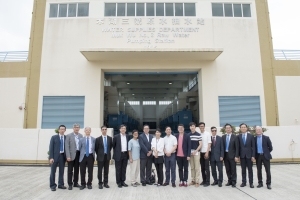 |
| After the duty visit to Dongjiang (DJ), the Development Bureau and the Water Supplies Department (WSD) arranged another visit for LegCo Members to the Muk Wu Pumping Station in Hong Kong. |
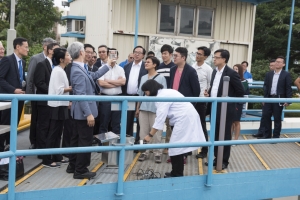 |
| On-site demonstration by our chemists to LegCo Members of the usual ways to collect DJ water samples. |
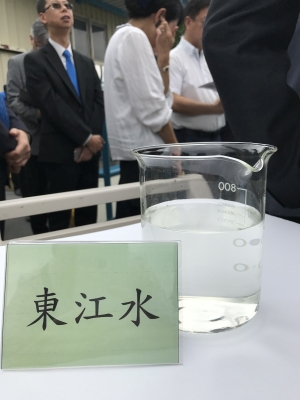 |
| A sample of DJ water collected. |
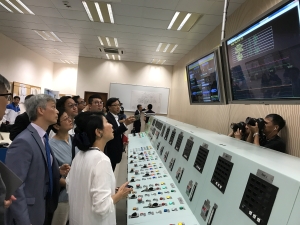 |
| LegCo Members listen attentively to a briefing at the DJ water quality surveillance station at the Muk Wu Pumping Station. |
 |
| The Tai Po Water Treatment Works is undergoing expansion. |
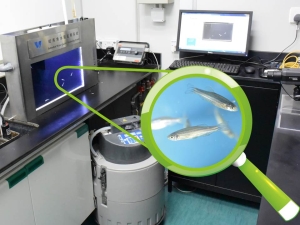 |
| A patent has been registered for the Zebrafish Water Quality Monitoring System developed by the WSD. |
 |
| The dissolved air floatation clarifier is an innovative water treatment technology; it is normal to see a layer of sludge float at the water surface. |
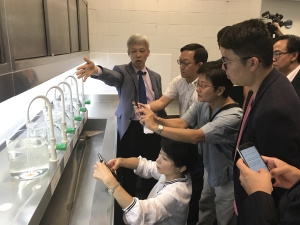 |
| LegCo Members are interested in the multi-tier water treatment process for DJ water. |
 |
| In concluding the visit to the Tai Po Water Treatment Works, LegCo Members hope that the communication can continue in future. |
|